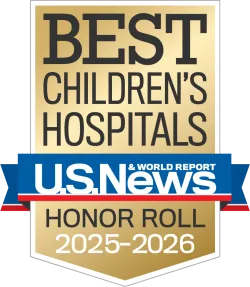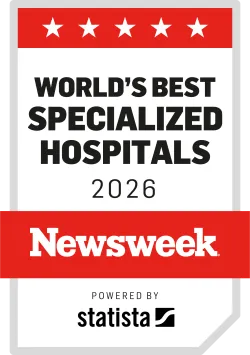Breadcrumb
- Home
- Conditions & Treatments
- Down Syndrome
What is Down syndrome?
Down syndrome is a genetic condition that happens when a child is born with an extra chromosome. The extra chromosome affects the way the child’s brain and body develop, leading to developmental delays, intellectual disability, and an increased risk for certain medical issues.
Down syndrome is the most common genetic cause of intellectual disability, affecting approximately 1 in every 700 children. It is named for John Langdon Down, the British physician who first recognized the traits of Down syndrome in 1866.
The chance that a baby will be born with Down syndrome increases with a mother’s age:
- 1 baby out of every 1,000 born to women under age 30
- 1 baby out of every 400 born to women older than 35
- 1 baby out of every 60 born to women older than 42
Some expectant parents choose to undergo prenatal testing to find out in advance if their child will have Down syndrome. These optional tests, performed during pregnancy, can identify a fetus’s sex, age, size, and placement in the uterus. They can also detect conditions such as Down syndrome, congenital heart defects, genetic conditions, and other birth defects.
Down syndrome and intellectual disability
Most children with Down syndrome have some level of intellectual disability ⎯ usually in the mild to moderate range. People with mild intellectual disability are usually able to learn how to do everyday things like read, hold a job, and take public transportation on their own. People with moderate intellectual disability usually need more support.
Many children with Down syndrome can participate in regular classrooms, though they may need extra help or modifications. Thanks to widespread special education and community programs, more and more people with Down syndrome graduate from high school, attend college, and work in their communities.
To help children with Down syndrome reach their highest potential, parents can seek out assistance programs as early as possible. By law, every state must provide developmental and special education services for children with Down syndrome, starting at birth with early Intervention and then continuing with public education until age 21.
Down syndrome and medical problems
Children with Down syndrome can have a variety of health issues. About half are born with a congenital heart defect, a structural problem with the heart that develops during pregnancy.
The most common congenital heart defects in children with Down syndrome include:
- Atrioventricular septal defect, the most common heart defect in children with Down syndrome
- Patent ductus arteriosus
- Tetralogy of Fallot
Many children with heart defects also develop pulmonary hypertension, a condition that can cause lasting lung damage if left untreated.
Other health issues that commonly affect children with Down syndrome include:
Symptoms & Causes
What causes Down syndrome?
Down syndrome is a common genetic condition that occurs when a child has an extra copy of chromosome 21.
Chromosomes are structures inside every human cell that contain DNA. These tiny structures that children inherit from their parents play a key role in determining how a baby develops, for instance, whether they will be tall or short, have dark or light skin, or curly or straight hair.
Normally, a mother's egg and a father's sperm each start out with 23 chromosomes. When the egg and sperm meet at conception, a child inherits 23 chromosomes from each parent, ending up with a total 46 chromosomes.
In Down syndrome, a change occurs during cellular division such that the egg or sperm has an extra chromosome 21. Researchers are still unsure of what causes the cells to divide in this manner (though the chance of this happening increases with increasing maternal age). If this egg or sperm is fertilized, the baby ends up with three copies of chromosome 21 or Trisomy 21. This extra genetic material causes the health and developmental issues of Down syndrome.
What are the symptoms of Down syndrome?
Down syndrome can affect children physically, cognitively, and behaviorally. Every child with the condition is unique and may possess the following characteristics to different degrees, or not at all.
Physical characteristics
Children with Down syndrome have some of the following physical features:
- Eyes that slant upward, from inner corner to outer corner
- Small ears that may fold over slightly at the top
- A smaller-than-average mouth, and larger appearing tongue
- A smaller-than-average nose, with a flattened nasal bridge
- Short, stocky arms and legs
- A wide space between the big toe and second toe
- Short necks and small hands with short fingers
- One single crease that goes straight across the palm, and a second crease that curves down by the thumb, rather than three creases in the palm of the hand
- Shorter-than-average height
- Low muscle tone (hypotonia) throughout the body and excessively loose joints
Developmental, cognitive, and behavioral symptoms
Most children with Down syndrome meet developmental milestones later than other children, including the ability to walk and talk. They often have mild to moderate intellectual disability and may have specific challenges with attention span, verbal memory, and expressive communication.
Behavioral problems such as stubbornness, impulsivity, and temper tantrums may be more common in children with Down syndrome. Many children talk out loud to themselves as a way of understanding and processing information.
On the other hand, many children with Down syndrome have strong social skills. Even as infants, many use non-verbal communication to connect with others. They are often strong visual learners, understanding information best when they can see it, either through pictures, objects, or demonstration. Many children with Down syndrome learn to read words sooner than their parents or teachers expect.
Diagnosis & Treatments
How is Down syndrome diagnosed?
Down syndrome can be detected during pregnancy through prenatal tests or diagnosed after birth with a chromosomal analysis called a karyotype.
Prenatal tests
Prenatal tests are optional tests that can be performed during pregnancy to identify a fetus’ sex, age, size, and placement in the uterus. Prenatal tests also detect chromosomal conditions such as Down syndrome, congenital heart defects, and other genetic conditions.
Prenatal tests and timing
Ideally, the best time to start thinking about prenatal tests is before conception. Your doctor can look at your family’s medical history to see if the parents might have an increased risk for having a child with a genetic condition such as Down syndrome. Sometimes, the doctor will recommend pre-conception testing for parents' articular conditions based on this evaluation.
Before any parent decides whether or not to get prenatal testing, it’s important to know all the options and the advantages and disadvantages of each one.
Screening tests
Screening tests determine the likelihood of Down syndrome and other medical conditions without providing a definite diagnosis.
The different types of screening tests include:
- Blood tests that measure protein and hormone levels in pregnant women. Abnormal levels, whether high or low, can indicate a genetic condition.
- Ultrasound, a non-invasive imagining technique that uses sound waves to generate an image of the fetus. An ultrasound can identify congenital heart conditions and other structural changes such as extra skin at the base of the neck that may indicate Down syndrome.
Clinicians use the combined results of blood tests and ultrasound results to estimate the chance that a fetus has Down syndrome.
Based on the results of the screening tests and the mother’s age, a clinician may recommend follow-up tests such as MaterniT21 or Panorama to look for fetal DNA in the maternal blood. These relatively new tests indicate if there is a high or low probability that a fetus has Down syndrome. These tests are not diagnostic and cannot say with absolute certainty whether or not a fetus has Down syndrome.
Diagnostic tests
Diagnostic tests can determine whether a fetus has Down syndrome with nearly 100 percent accuracy. However, because these tests require using a needle to obtain a sample from within the uterus, they carry a small increased risk of miscarriage and other complications.
Diagnostic test options include:
- Chorionic villus sampling (CVS), a prenatal diagnosis method in which a small biopsy of the placenta is taken for specific genetic testing. CVS is used to detect any condition that involves specific chromosomal abnormalities, like Down syndrome. This test is usually performed during the first trimester between 10 and 14 weeks of gestation.
- Amniocentesis, a prenatal diagnosis method in which a needle is inserted into the amniotic sac that surrounds the fetus. Amniocentesis is most often used to detect Down syndrome and other chromosomal abnormalities. This test is usually done in the second trimester, after 15 weeks of gestation.
Testing for related conditions
- Ultrasounds use sound waves to create an image of a fetus’ internal organs so clinicians can look for markers of Down syndrome and other possible issues like intestinal
- Echocardiograms use sound waves to create an image of the heart so doctors can look for signs of congenital heart defects
- Fetal magnetic resonance imaging (MRI) provides clinicians an image of a fetus’ internal organs, including the brain and intestines
Diagnostic testing after birth
Down syndrome can also be diagnosed after a baby is born. Clinicians can usually tell if a baby should be tested for Down syndrome based on a physical examination.
The first test, a rapid blood test (FISH), confirms the presence of extra material from chromosome 21. Results are available within a few days.
A karyotype test is a blood test that takes about one to two weeks for results. This provides further information on the type of Down syndrome, which is important in determining the chance of trisomy 21 in a future pregnancy.
How is Down syndrome treated?
While there is no cure for Down syndrome, there are a variety of treatments and therapies to address a child's unique medical issues and developmental profile.
Medical treatment
Almost half of children with Down syndrome are born with congenital heart defects. Babies with congenital heart conditions are treated by pediatric cardiologists, doctors who specialize in diagnosing and treating heart problems.
Treatment is based on the severity of the child's heart condition. Some mild heart defects don't require any treatment. Others can be treated with medications, interventional procedures, or surgery.
Depending on the child’s other medical issues, medications can treat conditions like seizure disorders, hypothyroidism, and childhood leukemia. Surgery may be necessary to treat upper neck abnormalities and stomach problems.
Physical and behavioral therapies
A variety of therapies are available to address a child's unique physical, behavioral, and communication needs and can have a significant positive impact on children’s learning and development.
Therapies include:
- Occupational therapy to improve motor skills, such as using the hands and other parts of the body, and help children deal with sensory inputs from the environment
- Physical therapy to increase mobility and muscle strength and help children to work within functional limitations
- Speech therapy to help improve communication skills and self-expression
- Behavioral therapy focused on managing emotional and behavioral problems
Educational therapy
Most of the educational therapies used to address the core symptoms of Down syndrome are provided through programs run by states and local school systems.
It’s important for parents and teachers to understand that no single educational approach is right for every child. Most children with Down syndrome can spend at least some of their time in a general education classroom with typically developing peers but some children can benefit from a smaller setting with more individual support.
- Children under age 3 who have Down syndrome or other developmental challenges are eligible to receive developmental services through state-run, federally mandated programs. These programs have different names in each state. In Massachusetts, the program is called Early Intervention, administered by the Massachusetts Department of Public Health.
- From age 3 to age 21, children can access educational support through their public school system.
What is the long-term outlook for children with Down syndrome?
The average life span for people with Down syndrome has increased dramatically since the early 1900s. On average, people with Down syndrome live to about 55 to 60 years of age and some live into the 70s or 80s.
With the help of specialized educational programs and support, many children with Down syndrome learn and grow successfully. An increasing number of people with Down syndrome graduate from high school. Some young people with Down syndrome take college classes and many hold jobs in the community after they finish school. Some adults with Down syndrome live independently or in community-based homes or supported living arrangements, where they can get additional support depending on their needs.
How we care for Down syndrome
The Boston Children’s Hospital Down Syndrome Program is one of the oldest and largest programs for children with Down syndrome and their families. The program is a subspecialty of the Developmental Medicine Center.
From their first visit at Boston Children’s, new parents work with a team of professionals committed to supporting all of their child’s clinical, physical, and emotional needs. We provide specialized medical care, resources, support, and advocacy for children with Down syndrome from birth through age 22 and regularly make referrals to other specialty clinics at Boston Children's, depending on a child’s needs. We also help put parents in touch with other families with Down syndrome and connect them to community and educational services appropriate for their child.
For children born with heart defects, our Benderson Family Heart Center is the largest in the United States and one of the most specialized in the world. We provide a full range of care, and our specialists have extensive experience treating rare heart problems with results that are among the best in the world.
Support for expecting parents who receive a prenatal diagnosis of Down syndrome
The Down Syndrome Program works closely with the Fetal Care and Surgery Center. Depending on a family’s needs, we provide prenatal consultation to answer questions and help expecting parents learn more about Down syndrome. We offer confidential, non-directive counseling for families uncertain about their plans, providing a safe opportunity to gather information and make an informed decision about the pregnancy.
For families with a likely or confirmed diagnosis who plan to continue the pregnancy, the prenatal visit becomes the first clinical visit where we begin to help plan for the baby’s future. We discuss common medical conditions, developmental issues, education, and resources in the community.





